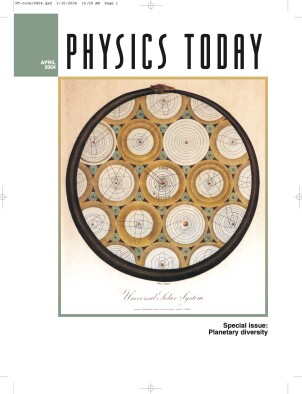H. Douglas Keith
DOI: 10.1063/1.1752439
For more than four decades, H. Douglas Keith was a leading figure in polymer physics. He died at his home in South Windsor, Connecticut, on 9 February 2003, following a yearlong battle with cancer.
Keith was born in Belfast, Northern Ireland, on 10 March 1927. He received a BSc from Queen’s University Belfast in 1948 and a PhD in physics from the University of Bristol in England in 1951.
For the next five years, he taught as a lecturer at Bristol, where he specialized in optics. During that time, Keith was influenced by and collaborated with Peter Paul Ewald, Nevill Mott, and Charles Frank. He emigrated to the US in 1956 after accepting a position at the American Viscose Corp in Marcus Hook, Pennsylvania. There, Keith became interested in the complex structures and morphologies exhibited by macromolecules, a class of condensed matter that was emerging as an important category of materials. Along with Frank J. Padden Jr, he began evaluating the optical properties of spherulites, entities that form during solidification of most crystalline polymers from the melt.
Keith, along with Padden, joined Bell Telephone Laboratories in Murray Hill, New Jersey, in 1960 and soon thereafter published a highly influential paper on spherulitic crystallization, subsequently known as the Keith and Padden theory. Over the next three decades, Keith interacted with a host of individuals to explain many of the mysteries surrounding the solidification of long-chain molecules.
In the early 1960s, he and Padden provided one of the first morphological descriptions of melt-crystallized isotactic polypropylene, a polymeric material that today is superseded only by polyethylene in commercial importance. Their systematic experimental methods and insightful analyses were applied to many systems, including polyesters, various poly-peptides, and other crystallizable polymers. In 1965, Keith and his colleagues discovered intercrystalline links in polymers, which helped explain their mechanical strength. Four years later, he led a group that produced the first chain-folded single crystals of DNA. That work established an important bridge between synthetic and naturally occurring macromolecules.
Keith was instrumental in expanding polymer science and engineering at Bell Laboratories during the 1970s. He headed the analytical chemistry research department and later the organic materials research department, from which a generation of young scientists and engineers began their research careers blending chemistry, physics, and engineering. A superb mentor, Keith combined a sophisticated understanding of physics with a deep appreciation for collaborative and interdisciplinary research. His encouragement and helpfulness to young scientists is legendary, particularly his unparalleled willingness to evaluate and debate new ideas and review manuscripts.
On retiring from what was then called AT&T Bell Laboratories in 1988, Keith moved to the University of Connecticut in Storrs, where he taught and continued his research with polymers until he became professor emeritus in 1996. He remained active in research and his last publication appeared just a couple of weeks before his death. His impact on the field of polymer science and engineering continues to be felt today.
Keith was a leader in the American Physical Society. He chaired the polymer physics division (1965–66) and was a divisional councillor (1977–85). He also headed the committee on applications of physics before it became the forum on industrial and applied physics. In 1973, Keith, with Padden, received APS’s Polymer Physics Prize. He was also a fellow of the American Association for the Advancement of Science.
Outside of his profession, Keith maintained many interests. He was an accomplished choral singer and a passionate golfer, and was broadly knowledgeable in history, biography, literature, and music.
Those who knew Keith were impressed by his wisdom, common sense, erudition, and humor. He enriched the lives of many and served as a role model and mentor to a number of younger scientists worldwide who have gone on to make a name for themselves in polymer physics. He was universally recognized as a scholar and gentleman, and those who knew him remember him with great fondness.

H. Douglas Keith

More about the Authors
Andrew J. Lovinger. 1Arlington, Virginia, US .
Stephen Z. D. Cheng. 2 University of Akron, Akron, Ohio, US .
Frank S. Bates. 3 University of Minnesota, Minneapolis, US .
